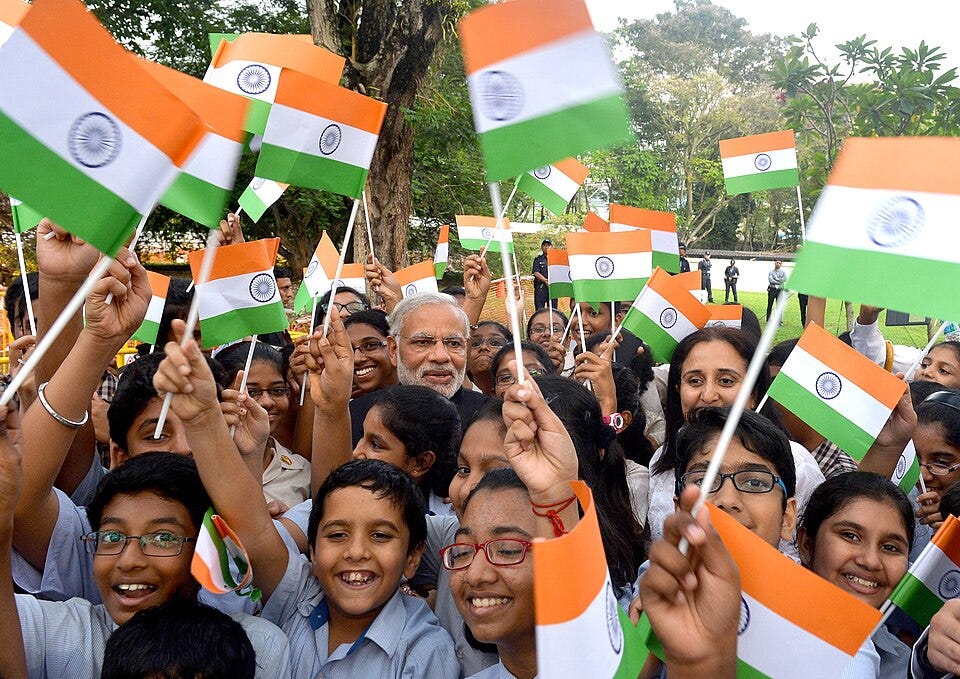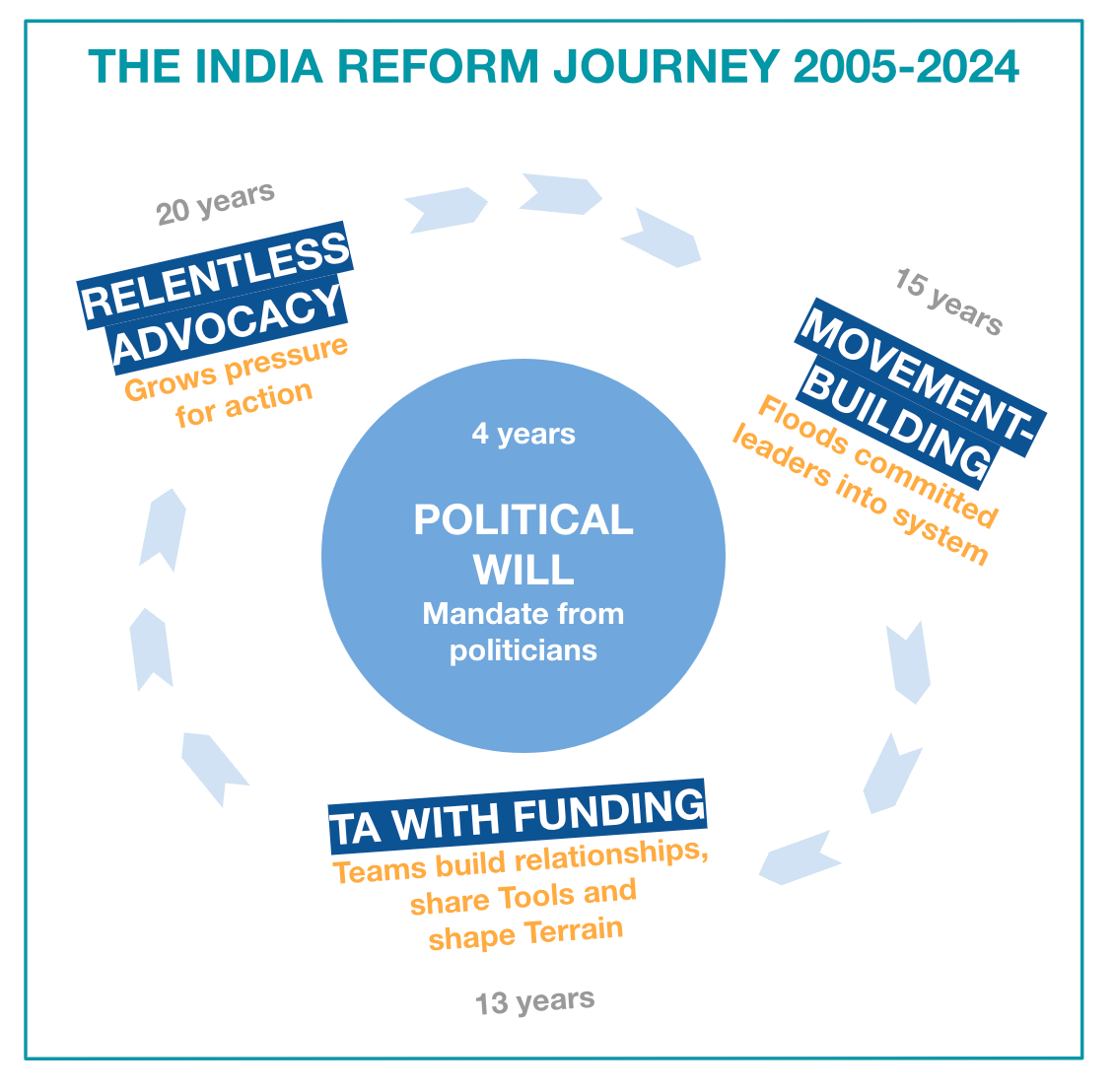The world's largest country improved primary schools at scale. How did they do it?
India's emerging FLN success story proves the long game pays off.

What was the biggest win for education reform globally since 2000?
Some point to Singapore, who topped PISA 2022 due to their teacher training policies.
It’s a no for me. (Singapore is a tiny country with a highly centralized government, and thus not the most useful reform case for most of the world.)
More importantly, the biggest country in the world, India, improved schools at massive scale despite deeply entrenched challenges.
In February, ASER 2024 showed meaningful gains in learning outcomes across India. Numeracy improved nationally by 6.5%. Uttar Pradesh state improved 15% in reading from 2018 to 2024. Bihar and Madhya Pradesh states also had promising gains. (More analysis of the results here.) Combined, these 3 states have a population of 461 million; if they were a country, they would be the 3rd largest country in the world. (UP alone is larger than Brazil!)
NOTE: India’s outcomes improved DESPITE Indian schools closing for 574 days during the Covid pandemic. For comparison, nearly all states in my home, the US, have drastically worse literacy outcomes in 2024 compared to 2019.
India’s ASER results are for foundational literacy and numeracy (in primary schools). We can’t declare victory yet, as there is a long way to go to the finish line (positive results are in only 6 of India’s 28 states, and we need further gains even in those states). But these results are historic. We have too few examples where governments in the Global South improved education outcomes, validated by non-government assessments. India can teach us how we can truly strengthen government schools to ensure a better education for kids worldwide.
What made these results possible?
From my interviews with Indian leaders and 6 trips to India, I believe it’s 4 factors:
Do you agree/disagree? Join the conversation in the comments.
1. RELENTLESS ADVOCACY
20 years to expose the crisis & grow pressure for action.
The first key is decades of work by Pratham to grow awareness that Indian schools are failing.
In 2005, the first ASER set out to find out: are Indian children learning? As Rukmini Banerjee wrote at the time, “in almost every district of the country, local people and local groups are taking a few days time out to visit villages, to meet families, to talk about schooling, to understand if children can read, to write and do arithmetic.”
This was a highly complicated, risky project for Pratham (what if future results showed no gains?) They continued ASER year after year. They mobilized thousands (26,000 just to do the 2024 ASER!)
But this bet paid off. The data was a powerful tool for activists to help leaders in government see what was really going on and why it was a problem. It sparked dialogue in the media and shaped Indian voters to care about education reform - which in turn influenced politicians and sparked a wave of momentum for change.
2. TECHNICAL ADVISORS with FUNDING
13 years of quiet relationship-building & opinion shaping.
Alongside this, Central Square Foundation (CSF) and other local non-profits, across 12 states and the federal level, supported government leaders as they started to care more about education. This happened in 3 ways:
Team + Tools + Terrain
The Team is hundreds of non-profit staff spread across the massive country of India - in central agencies, state teams, district teams, and school support - that emerged in just 3 years, from CSF, Language & Learning Foundation, the Education Alliance, Piramal Foundation, and many others. CSF started in 2012 (more about their model of systems change philanthropy here), the Education Alliance in 2014, and Language & Learning Foundation in 2015. In addition to domestic philanthropy, they were supported by global funders willing to make a long-term bet (such as $24.5 million from the Gates Foundation to CSF since 2018).
This Team is critical because they do the endless, tiring hard work to meet government leaders for chai (tea) across their desks piled high with papers, discuss their needs, connect them with Tools - and adapt to start fresh when elections shift who is in power.
Tools are the reform package for FLN - what the advisors actually support government to do. Think:
Policy that guides budgets & curriculum
Teacher guidebooks for structured pedagogy
Student workbooks
Coaches to observe teachers & help them improve
Assessment so teachers/school leaders/district, state, central leaders can all see whether & how students are learning
Terrain is the environment around government leaders, school leaders and teachers at every level. Indian non-profits learned that it is not enough to know ‘what works’ and have staff to share that package; we must shape the incentives facing leaders in the system. Leaders need a message and mandate to come from their bosses, in order to change what they DO.
This meant influencing the priorities of powerful people - publicly, through the media, and behind-the-scenes, in 1-1’s, breakfasts and informal chats with advisors trusted by government. For example, the first funder of CSF, CSF’s head and the head of LLF all publish op-eds in India’s most popular newspapers (recent examples here and here).
3. POLITICAL WILL
4 years of mandate from politicians at the top.
Most importantly, Indian politicians and leaders in the bureaucracy decided to tackle education and prioritize FLN. Government took action to push for FLN policies and create accountability, for all the other levels and government agencies to align around the same goals.
Political and economic forces determined how FLN became a priority when and where it did. Narendra Modi was elected Prime Minister in 2014. In 2020, the Union Cabinet approved a National Education Policy prioritizing FLN. In 2021, Modi’s Ministry of Education launched the NIPUN Bharat national FLN mission. Visionary state leaders - such as Dr. Parmod Kumar in Haryana, Rashmi Arun Shami in Madhya Pradesh and Vijay Kiran Anand in Uttar Pradesh - catalyzed reforms to roll out quickly. FLN District Coordinators, like Kusum Malik, led on the frontlines.
As Anustup Nayak from CSF told me, “in India, government does well with concrete missions. If we want to move the needle on anything, we have to get the system to focus on one thing at a time.”
NIPUN Bharat created shared goals for everyone to unite around - from Ministries of Finance, to state reform teams, school inspectors, principals and teachers. Although data and technical experts are important, the critical factor for India was a political window of opportunity and a nation-wide, razor-sharp goal. This was enabled by decades of leaders who prepared the ground and grew the movement for change, so they were ready take advantage of the window when it opened.
4. MOVEMENT-BUILDING
15 years of pipeline flooding committed leaders into the system.
Finally, the bedrock that made factors 1-3 possible, was how Fellowship programs identified talent with potential, shaped them to care about education, and grew them into a movement that fed leaders into critical positions for system transformation.
Teach for India started in 2009 and sent over 12,000 through their teaching Fellowship and other programs. TFI alumni went on to join existing government support organizations, or start new ones. 77% of alumni work in the social sector across teaching, leading schools, education policy, etc. For example, Mainak Roy launched Simple Education Foundation, which supports state governments on teacher training, and many CSF staff are TFI alumni. Anurag Kundu works on education in India’s Punjab state government.
Teach for India (like Teach for America in the US) played a catalytic role in India’s reform journey, because they attracted energetic leaders to tackle the education crisis instead of going into finance, law or medicine. This movement, combined with relentless advocacy, technical advisors with funding and political will, collectively created stronger FLN outcomes in 6 Indian states.
ASER 2024 showed progress, but India’s movement must keep pushing, percentage point by percentage point. I hope 10 years from now, we will have even stronger results in government schools across India - so we can share more of India’s success as an exemplar for the world to learn from.
A disclosure: through Lighthouse Coalition at Global Schools Forum, I partner with Central Square Foundation, Language & Learning Foundation, the Education Alliance and the Gates Foundation. In 2026, we'll take government leaders from Brazil, Kenya and South Africa to witness India's education reforms!This is part of my forthcoming book on how we improve education (‘The Systems Change Playbook’) - with tactics, examples and leadership case studies from Brazil, Nigeria, Kenya, Pakistan, India and Indonesia. For more tools, read about one of the world’s largest school operators (in Pakistan), the Sobral reforms (in Brazil), or travel in history to learn about the oldest schools in the world or 16 educationists from the Global South.




Headline results seem amazing.
Exited to dig into data and methodology (my concern as usual is shifting the standards for excellence (moving goal posts) is the easiest move to make - if it feels too good to be true, need to look closely).